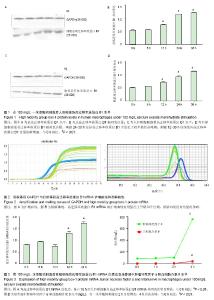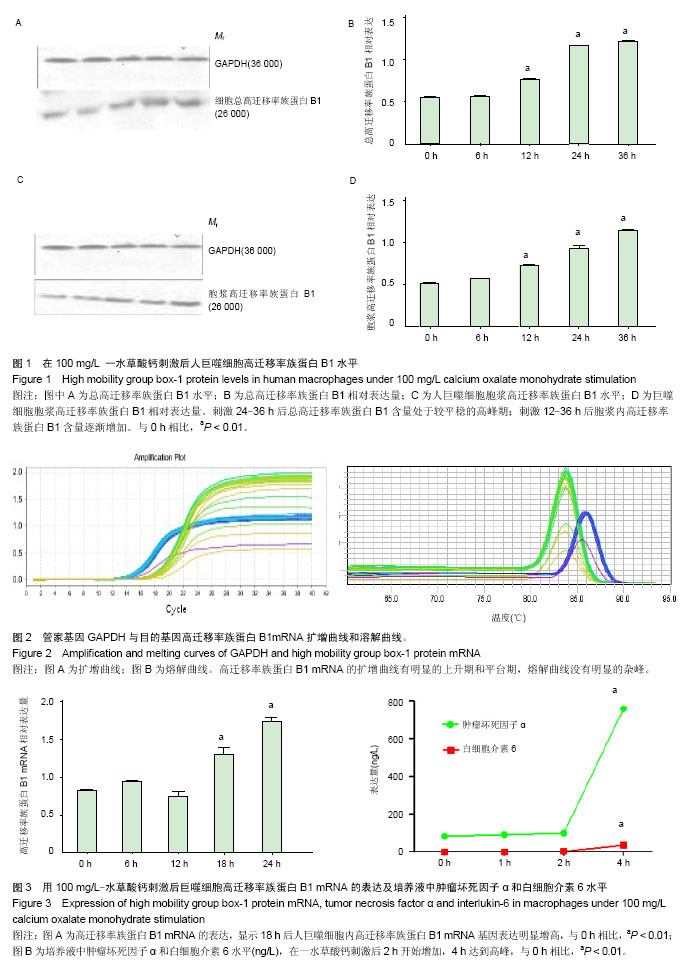Chinese Journal of Tissue Engineering Research ›› 2015, Vol. 19 ›› Issue (11): 1712-1716.doi: 10.3969/j.issn.2095-4344.2015.11.014
Previous Articles Next Articles
Calcium oxalate crystals stimulate expression of high mobility group box-1 protein in human macrophages
Huang Peng, Deng Yao-liang, Li Cheng-yang, Tao Zhi-wei, Wang Xiang, Feng You-cai, Wu Bo
- Department of Urinary Surgery, First Affiliated Hospital of Guangxi Medical University, Nanning 530021, Guangxi Zhuang Autonomous Region, China
-
Revised:2015-01-06Online:2015-03-12Published:2015-03-12 -
About author:Huang Peng, Master, Department of Urinary Surgery, First Affiliated Hospital of Guangxi Medical University, Nanning 530021, Guangxi Zhuang Autonomous Region, China
CLC Number:
Cite this article
Huang Peng, Deng Yao-liang, Li Cheng-yang, Tao Zhi-wei, Wang Xiang, Feng You-cai, Wu Bo . Calcium oxalate crystals stimulate expression of high mobility group box-1 protein in human macrophages [J]. Chinese Journal of Tissue Engineering Research, 2015, 19(11): 1712-1716.
share this article

2.1 一水草酸钙刺激后人巨噬细胞总高迁移率族蛋白B1含量 用Western blot检测培养细胞中的总高迁移率族蛋白B1水平,结果显示一水草酸钙刺激0-6 h,细胞总高迁移率族蛋白B1含量不高,刺激12-36 h后总高迁移率族蛋白B1含量逐渐增加,与0 h相比有明显差异(P < 0.01);刺激24-36 h后总高迁移率族蛋白B1处于较平稳的高峰期(图1A,B)。 2.2 一水草酸钙刺激后人巨噬细胞细胞浆高迁移率族蛋白B1含量 用Western blot检测细胞浆,结果显示一水草酸钙刺激0-6 h,胞浆内高迁移率族蛋白B1含量较低,刺激12-36 h后胞浆内高迁移率族蛋白B1含量逐渐增加,与 0 h相比差异有显著性意义(P < 0.01)(图1C,D)。 2.3 一水草酸钙刺激后人巨噬细胞高迁移率族蛋白B1 mRNA的表达 用100 mg/L的一水草酸钙刺激人巨噬细胞,以GAPDH作为校正基因,高迁移率族蛋白B1 mRNA的扩增曲线有明显的上升期和平台期,熔解曲线没有明显的杂峰。一水草酸钙刺激后0-12 h 人巨噬细胞内高迁移率族蛋白B1 mRNA基因无明显变化,18 h后人巨噬细胞内高迁移率族蛋白B1 mRNA基因表达明显增高,与0-12 h相比差异有显著性意义(P < 0.01),见图2,图3A。 2.4 一水草酸钙刺激后人巨噬细胞培养液中肿瘤坏死因子α和白细胞介素6的水平 用双抗体夹心法检测细胞培养液中肿瘤坏死因子α和白细胞介素6水平,结果显示,细胞培养液中肿瘤坏死因子α和白细胞介素6在一水草酸钙刺激后2 h开始增加,4 h达到高峰,与0 h相比差异有显著性意义(P < 0.01),见图3B。"

| [1] De Water R, Noordermeer C, Houtsmuller AB, et al.The role of macrophages in nephrolithiasis in rats:An analysis of the renal interstitium. Am J Kidney Dis.2000;36:615-625. [2] Khan SR. Crystal-induced inflammation of the kidney:results from human studies,animal models,and tissue culture studies. Clin Exp Nephrol.2004;8(2):75-88. [3] Li J,Kokkola R,Tabibzadeh S,et al.Structural basis for the proinflam matory cytokine activity of high mobility group box1. Mol Med.2003;9(1-2):37-45. [4] Lotze MT,Tracey KJ.High-mobility group box 1 protein (HMGB1): nuclear weapon in the immune arsenal.Nature Rev Immunol.2005;5(4):331-342. [5] Sapojnikova N,Maman J,Myers FA,et al. Biochemical observation of the rapid mobility of nuclear HMGB1. Biochim Biophys Acta.2005;1729(1):57-63. [6] Li W, Sama A E, Wang H. Role of HMGB1 in cardiovascular dis-eases. Curr Opin Pharmacol.2006;6(2):130-135. [7] Mantell LL, Parris W R, Ullea L. Hmgb-1 as a therapeutic target for infectious and inflammatory disorders. Shock. 2006; 25(1):4-11. [8] Chen X,Li W,Wang H.More tea for septic patients-Green tea may reduce endotoxin-induced release of high mobility group box l and other pro-inflammatory cytokines. Med Hypotheses. 2006;66(3):660-663. [9] de Water R, Leenen PJ, Noordermeer C,et al.Cytokine production induced by binding and processing of calcium oxalate crystals in cultured macrophage.Am J Kidney Dis. 2001;38(2):331-338. [10] Wang HC, Bloom O, Zhang MH, et al. HMG-1as a late mediator of endotoxin lethality in mice. Science.1999;285(5425):248-251. [11] Fiuza C,Bustin M,Talwar S,et al. Inflammatory promoting activity of HMGBI on human microvascular endothelial ceHs. Blood.2003;101(7):2652-2660. [12] Paehot A, Monneret G, Voifin N, bet al. Longitudinal study of cytokine and immune transcription factor mRNA expression in septic shock. Clinical Immunology.2005;114(1):61-69. [13] Harris HE, Andersson U. The nuclear protein HMGBI as a proinflammatory mediator. Eur J Immunol.2004;34(6): 1503-1512. [14] 奉有才,邓耀良,陶芝伟,等.吴博高迁移率族蛋白B1对磷酸钙诱导巨噬细胞释放炎症因子的协同作用[J].中国组织工程研究, 2014,18(33):5317-5322. |
| [1] | Chen Ziyang, Pu Rui, Deng Shuang, Yuan Lingyan. Regulatory effect of exosomes on exercise-mediated insulin resistance diseases [J]. Chinese Journal of Tissue Engineering Research, 2021, 25(25): 4089-4094. |
| [2] | Chen Yang, Huang Denggao, Gao Yuanhui, Wang Shunlan, Cao Hui, Zheng Linlin, He Haowei, Luo Siqin, Xiao Jingchuan, Zhang Yingai, Zhang Shufang. Low-intensity pulsed ultrasound promotes the proliferation and adhesion of human adipose-derived mesenchymal stem cells [J]. Chinese Journal of Tissue Engineering Research, 2021, 25(25): 3949-3955. |
| [3] | Yang Junhui, Luo Jinli, Yuan Xiaoping. Effects of human growth hormone on proliferation and osteogenic differentiation of human periodontal ligament stem cells [J]. Chinese Journal of Tissue Engineering Research, 2021, 25(25): 3956-3961. |
| [4] | Sun Jianwei, Yang Xinming, Zhang Ying. Effect of montelukast combined with bone marrow mesenchymal stem cell transplantation on spinal cord injury in rat models [J]. Chinese Journal of Tissue Engineering Research, 2021, 25(25): 3962-3969. |
| [5] | Gao Shan, Huang Dongjing, Hong Haiman, Jia Jingqiao, Meng Fei. Comparison on the curative effect of human placenta-derived mesenchymal stem cells and induced islet-like cells in gestational diabetes mellitus rats [J]. Chinese Journal of Tissue Engineering Research, 2021, 25(25): 3981-3987. |
| [6] | Hao Xiaona, Zhang Yingjie, Li Yuyun, Xu Tao. Bone marrow mesenchymal stem cells overexpressing prolyl oligopeptidase on the repair of liver fibrosis in rat models [J]. Chinese Journal of Tissue Engineering Research, 2021, 25(25): 3988-3993. |
| [7] | Liu Jianyou, Jia Zhongwei, Niu Jiawei, Cao Xinjie, Zhang Dong, Wei Jie. A new method for measuring the anteversion angle of the femoral neck by constructing the three-dimensional digital model of the femur [J]. Chinese Journal of Tissue Engineering Research, 2021, 25(24): 3779-3783. |
| [8] | Meng Lingjie, Qian Hui, Sheng Xiaolei, Lu Jianfeng, Huang Jianping, Qi Liangang, Liu Zongbao. Application of three-dimensional printing technology combined with bone cement in minimally invasive treatment of the collapsed Sanders III type of calcaneal fractures [J]. Chinese Journal of Tissue Engineering Research, 2021, 25(24): 3784-3789. |
| [9] | Qian Xuankun, Huang Hefei, Wu Chengcong, Liu Keting, Ou Hua, Zhang Jinpeng, Ren Jing, Wan Jianshan. Computer-assisted navigation combined with minimally invasive transforaminal lumbar interbody fusion for lumbar spondylolisthesis [J]. Chinese Journal of Tissue Engineering Research, 2021, 25(24): 3790-3795. |
| [10] | Hu Jing, Xiang Yang, Ye Chuan, Han Ziji. Three-dimensional printing assisted screw placement and freehand pedicle screw fixation in the treatment of thoracolumbar fractures: 1-year follow-up [J]. Chinese Journal of Tissue Engineering Research, 2021, 25(24): 3804-3809. |
| [11] | Shu Qihang, Liao Yijia, Xue Jingbo, Yan Yiguo, Wang Cheng. Three-dimensional finite element analysis of a new three-dimensional printed porous fusion cage for cervical vertebra [J]. Chinese Journal of Tissue Engineering Research, 2021, 25(24): 3810-3815. |
| [12] | Wang Yihan, Li Yang, Zhang Ling, Zhang Rui, Xu Ruida, Han Xiaofeng, Cheng Guangqi, Wang Weil. Application of three-dimensional visualization technology for digital orthopedics in the reduction and fixation of intertrochanteric fracture [J]. Chinese Journal of Tissue Engineering Research, 2021, 25(24): 3816-3820. |
| [13] | Sun Maji, Wang Qiuan, Zhang Xingchen, Guo Chong, Yuan Feng, Guo Kaijin. Development and biomechanical analysis of a new anterior cervical pedicle screw fixation system [J]. Chinese Journal of Tissue Engineering Research, 2021, 25(24): 3821-3825. |
| [14] | Lin Wang, Wang Yingying, Guo Weizhong, Yuan Cuihua, Xu Shenggui, Zhang Shenshen, Lin Chengshou. Adopting expanded lateral approach to enhance the mechanical stability and knee function for treating posterolateral column fracture of tibial plateau [J]. Chinese Journal of Tissue Engineering Research, 2021, 25(24): 3826-3827. |
| [15] | Zhu Yun, Chen Yu, Qiu Hao, Liu Dun, Jin Guorong, Chen Shimou, Weng Zheng. Finite element analysis for treatment of osteoporotic femoral fracture with far cortical locking screw [J]. Chinese Journal of Tissue Engineering Research, 2021, 25(24): 3832-3837. |
| Viewed | ||||||
|
Full text |
|
|||||
|
Abstract |
|
|||||